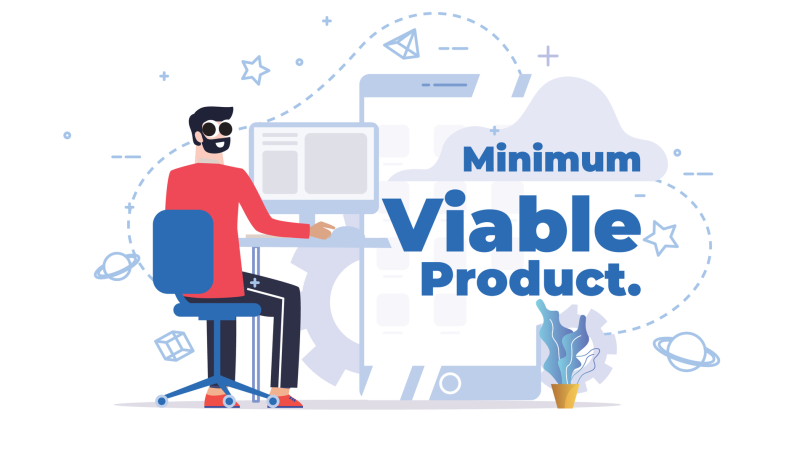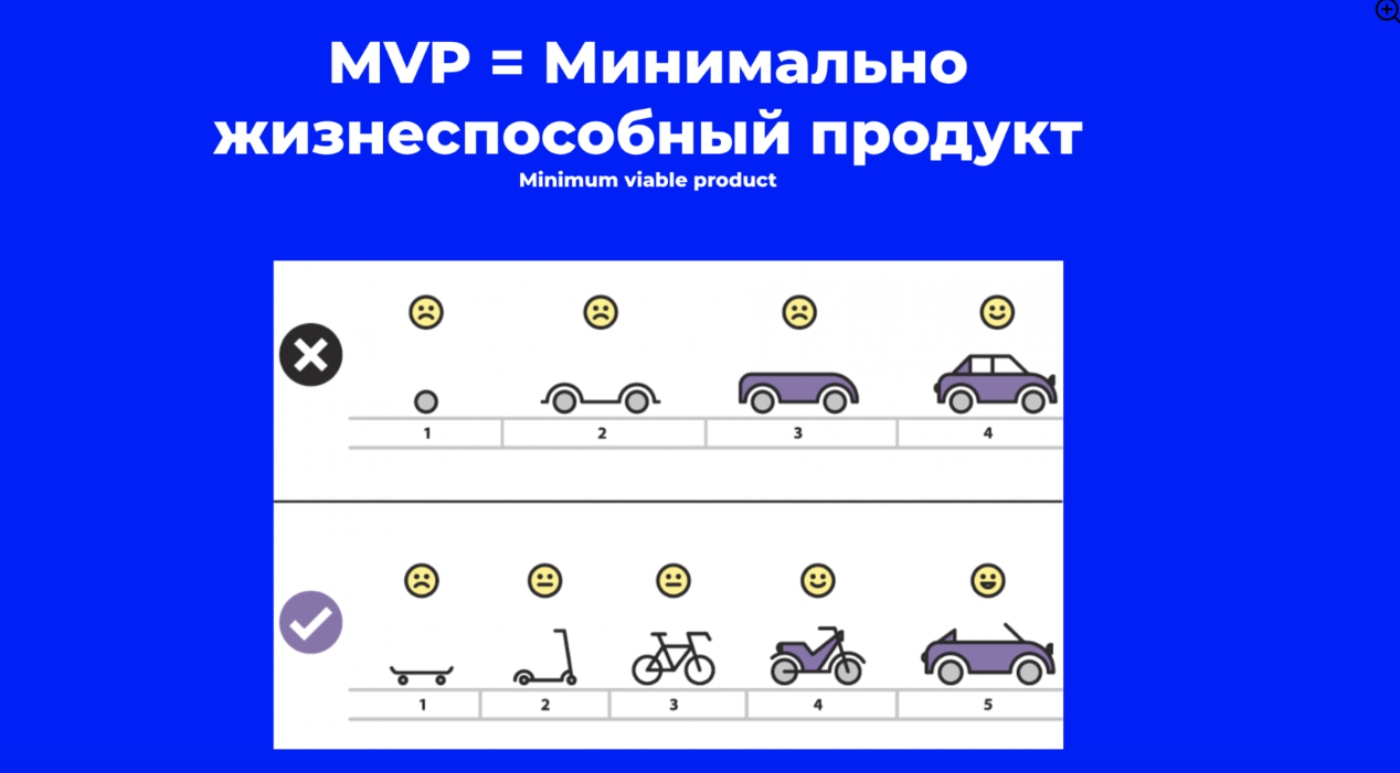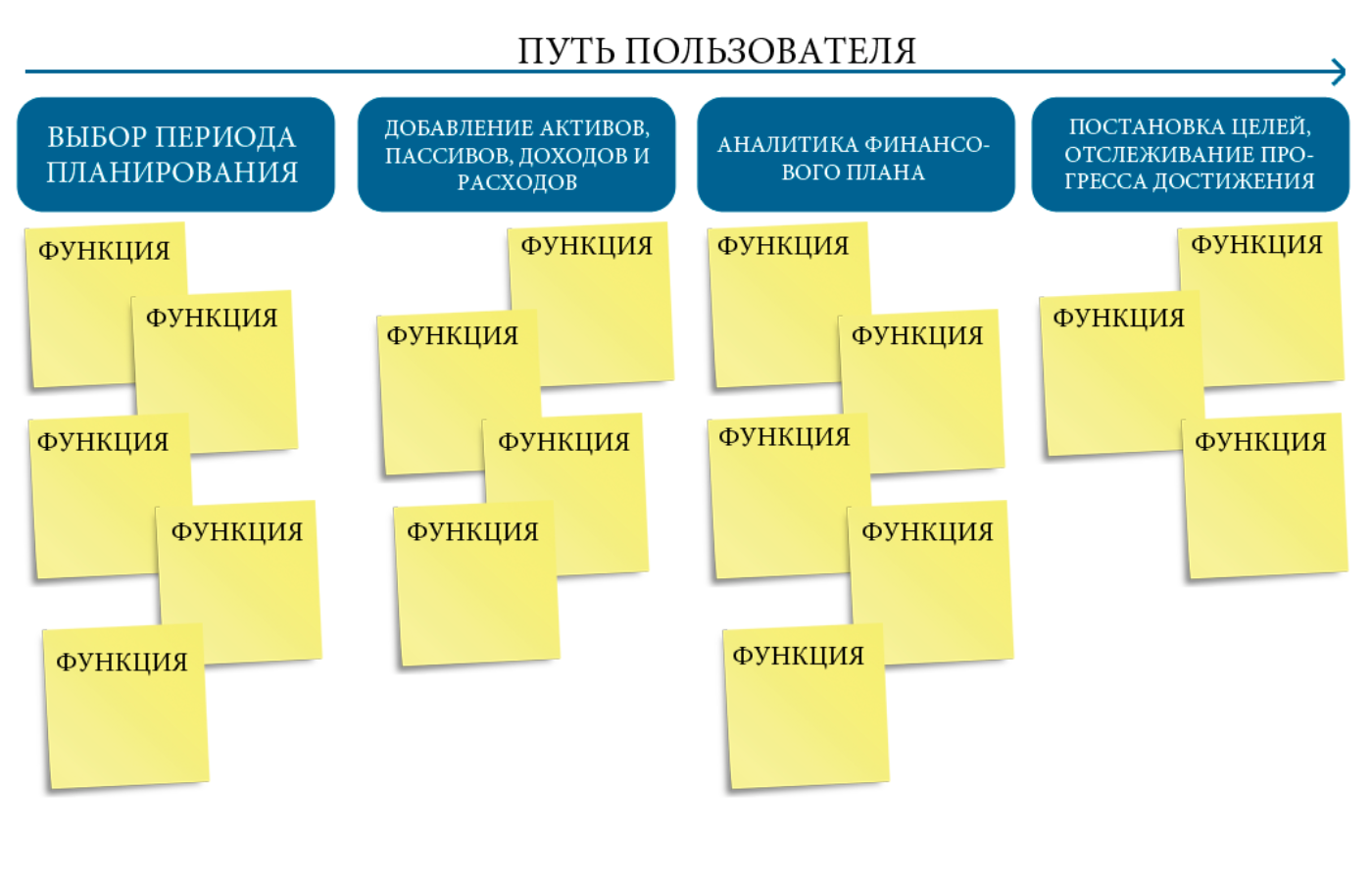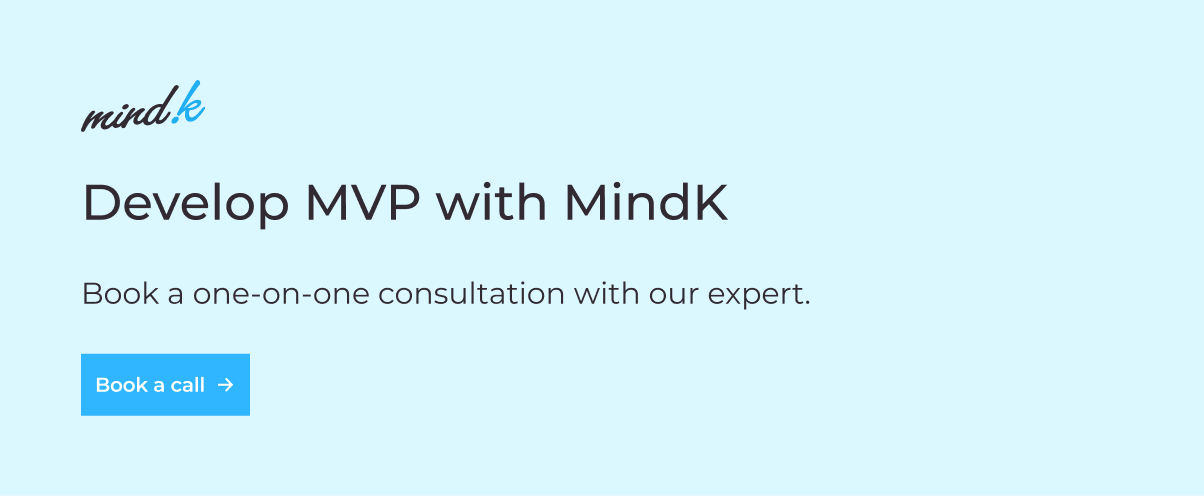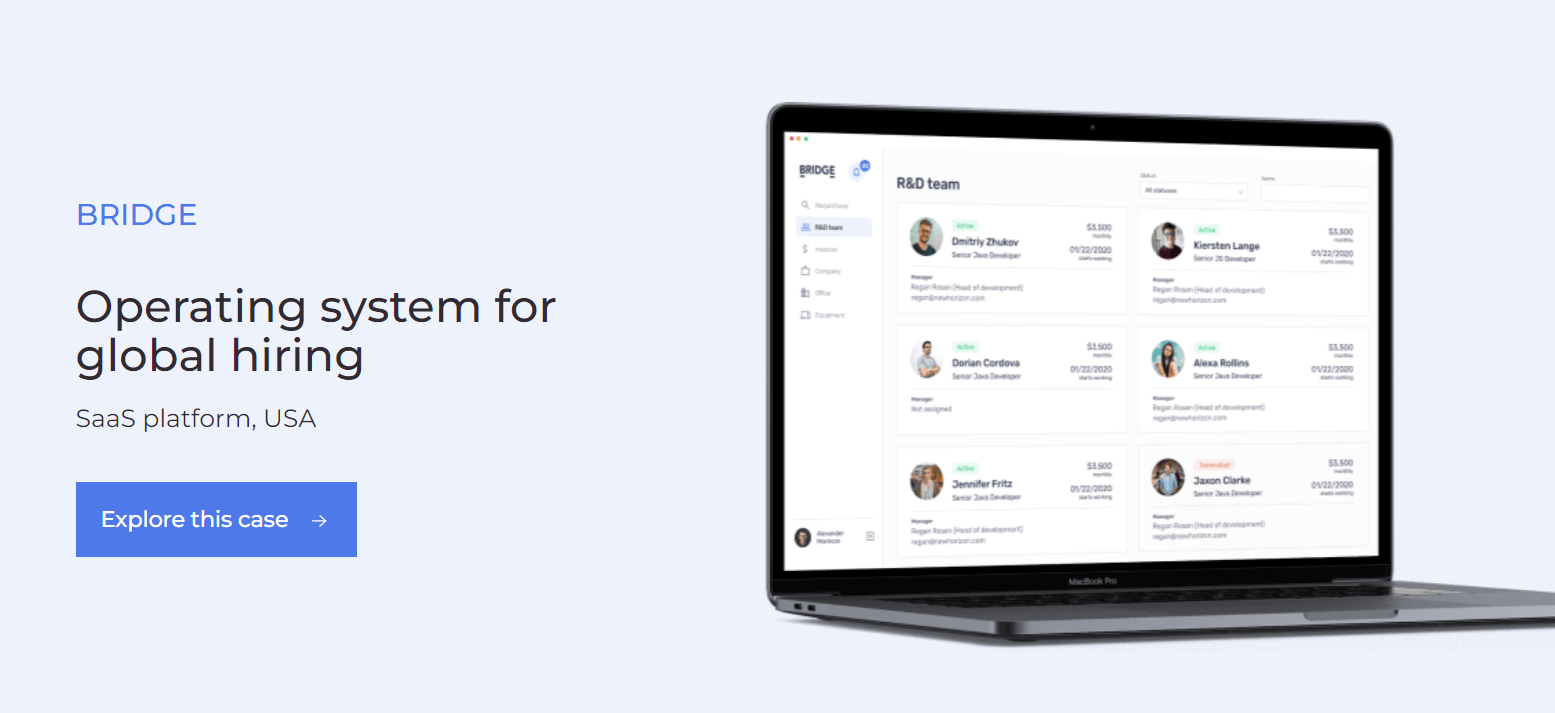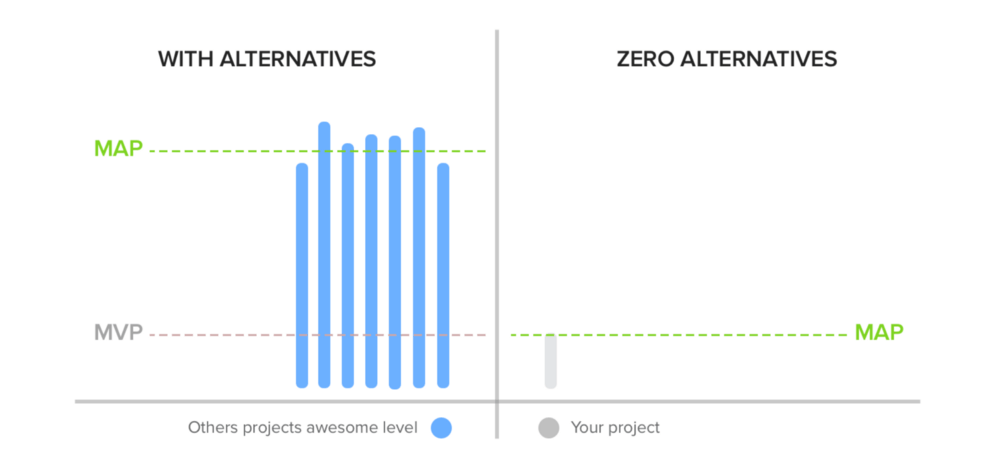What does mvp mean
What does mvp mean
What does mvp mean
Disclaimer: Minimum viable product is a kind of first form of a product for further market entry.
MVP stands for Minimum Viable Product. In a nutshell, it is a small version of a complete working solution that can be used and assessed by the first customers. This first exploitation of the product provides the developers with valuable feedback on what features need to be improved. In this article, we will focus on what MVP means for business, where it is good to be used and how to benefit from it.
Many businesses or individuals want to turn their brilliant ideas into solutions or products and earn a profit. But these experiments can cost a lot of money and ultimately not bring real results for the owners. So, what should you do in such a situation, and how can you minimize the risks?
Developing a minimum viable product is the solution. It helps not only to launch a product very quickly, but also to collect opinions about it from real users. Then, based on the feedback and reviews, companies decide whether or not to continue with the tool development.
MVP is a basic solution that emphasizes the main idea but without additional functionality or thought-out design to the smallest details. MVP stands for a 100% working product, in contrast to the prototype. On the basis of the MVP solution, through further development services, more and more new functions are added, the design is improved, and new ideas are tested.
Minimum viable product helps to deal with the following issues:
If the new product is accepted positively, it will be developed further. If consumers don’t like the main idea, owners have two choices:
Has anyone I know created MVPs? Sure, have a look:
Benefits for business
MVP enters the market with a core idea and key functionalities that will be tested. If people do not like the main idea of the solution, additional features will not change their minds.
Let’s look at this situation with an example that we all understand. In a restaurant, if you didn’t like the whole dish, but the sauce for the meat was good, this does not mean that you will order it next time just because of the sauce:)
Any business can create an MVP and benefit from it. Developing an MVP is not as costly as developing a whole product. It will show whether potential users are interested and what needs to be changed or improved. Here are some examples of the spheres where an MVP would be a nice first step.
It seems that MVP is a magic pill for any project. That is not quite true. Sometimes there are products that are easier to develop till the end than to waste time on creating just one part of them. MVP is useless if:
Besides MVP, there are a number of other concepts that have similar and distinctive features. Let’s take a closer look at each of them in order to delineate the options.
MVP vs. Minimum Marketable Product
The Minimal Marketable Product (MMP) is a complete solution to sell, with minimal features but ready to generate full-fledged sales. The main difference between these two options is that MMP aims to reduce time-to-market while the MVP phase stands for risk reduction.
MVP vs. Proof of Concept
Proof of concept can be a preparatory stage before building an MVP project. The business idea and technical capabilities of the team are tested, but without the involvement of customers and the possible collection of feedback. Proof of concept remains an internal product without going to the market.
MVP vs. Minimum Lovable Product
The Minimum Lovable Product (MLP) name speaks for itself. This is a product with a minimum set of features, made with one goal in mind: to win the clients’ hearts. You can imagine MLP as a quality version of an MVP variant that customers will immediately fall in love with. Depending on the product or solution, MVPs can be delivered in different ways.
MVP vs. Beta Version
The difference between these two approaches is the degree of readiness of the products. MVP stands for the minimal version of the final solution, as a beta version is an almost ready product with all the functionality (basic and additional). The latter concept refers to the testing phase before launching the application. It’s the last preproduction phase to collect feedback, find the latest bugs, and go to market.
Conclusion
Creating a Minimum Viable Product is a helpful solution to test the future of the product. It conveys important data on the success of the product and allows companies to save money. Key functionality of the product will interest users or turn them away. An MVP is a fully-fledged product, not a quickly made prototype. Thus, the development of an MVP should be taken seriously, otherwise the resources will be wasted and no valuable feedback will be received. Designing an MVP is a key step on the way to a successful product launch.
What does MVP stand for?
What does MVP mean? This page is about the various possible meanings of the acronym, abbreviation, shorthand or slang term: MVP.
Most Valuable Player
Most Valuable Professional
Mitral Valve Prolapse
Most Valuable Primate
Most Valued Professional
Music And Video Player
Music Video Player
MindSolve Visual Performance
Most Valuable Performer
Music Video Pictures
Marginal Value Product
Most Valuable Person
The Mark Varney Project
Most Valueable Player
Michael Vescera Project
Moreno Valley Perris
Most Valued Player
Most Valuble Player
Most Valuable People
Music Video Producer
Music Videos And Pictures
Mohawk Valley Plan
Microsoft Valuable Professional
Most Volatile Player
Maximum Vertical Pocket
What does MVP mean?
Popularity rank for the MVP initials by frequency of use:
Couldn’t find the full form or full meaning of MVP?
Maybe you were looking for one of these abbreviations:
Discuss these MVP abbreviations with the community:
Report Comment
We’re doing our best to make sure our content is useful, accurate and safe.
If by any chance you spot an inappropriate comment while navigating through our website please use this form to let us know, and we’ll take care of it shortly.
MVP (Minimum Viable Product)
What is MVP?
MVP is the earliest product version with a minimum set of features sufficient for initial presentation and testing on the target audience. However, despite the ‘early’ characteristic, this product should already be of real value to consumers. MVP stands for Minimum Viable Product.
The benefits of MVP
MVP development is irreplaceable for business, especially for start-ups, because it allows you to
The disadvantages of MVP
The disadvantages of MVP are:
What is MVP (minimum viable product) in business?
MVP (minimum viable product) in marketing
With MVP, you can test the product and the marketing strategy. For example, a mailing list measures the number of interactions and leads generated. MVP also allows you to evaluate: conversions, return rates, cost per lead, average check, operational costs, and even design.
When it comes to how to do MVP marketing, and it is essential for a full demonstration and feedback gathering, adhere to a few rules of thumb:
MVP development: types and varieties of products
Before you start MVP development, you need to decide what kind of minimum viable product you need:
How to create a minimum viable product (MVP)
It’s most comfortable and safe to use Agile to create an MVP. However, you can also employ other management strategies. Creation takes place in a few steps, regardless of business or type:
A book or course on MVPs can help you learn all these steps more quickly in practice.
Learning by topic
Creating Goods From Scratch. Studying Consumers and Competitors
MVP: что это такое и как работает?
Читая новости про проекты и сервисы, вы могли часто сталкиваться с понятием MVP. Но что скрывается под этой аббревиатурой и почему MVP так часто используют на начальных этапах развития продукта? Давайте прямо сейчас вместе разберемся в этом.
Что собой представляет MVP
Minimal Viable Product (минимально жизнеспособный продукт) — тестовая версия товара, услуги или сервиса с минимальным набором функций (иногда даже одной), которая несет ценность для конечного потребителя.
MVP создают для тестирования гипотез и проверки жизнеспособности задуманного продукта, насколько он будет ценным и востребованным на рынке.
Результаты тестирования минимально жизнеспособного продукта и обратная связь от целевой аудитории помогают понять, стоит ли развивать проект дальше, какие изменения следует внести в стратегию, а что оставить в первоначальном виде.
В 2008 году, когда аренда отеля или жилья во время путешествия была большой проблемой, два энтузиаста решили подойти к вопросу нестандартно и сдали свою квартиру по простому факсу. По сути, это тоже MVP, в котором тестировалась основная функция. Эксперимент показал, что продукт получит спрос, а сегодня Airbnb — одна из крупнейших площадок по поиску краткосрочной аренды жилья.
MVP и PoC — одно и то же?
Proof of Concept (PoC) — доказательство правильности концепции и некоторые новички часто путают его с минимально жизнеспособным продуктом. PoC описывает процессы выяснения технической жизнеспособности концепции программного обеспечения (или любого другого продукта).
Да, эти определения взаимосвязаны, но не взаимозаменяемые. Proof of Concept — описание процессов на начальной стадии развития продуктов, которые потом реализуются фактически, из чего получается MVP.
Виды MVP
Есть много разных подходов к созданию минимально жизнеспособного продукта, но на практике чаще всего используют некоторые из них. Далее поговорим о наиболее популярных.
MVP Флинстоуна
Помните, как в популярном мультике «Флинстоуны» глава семейства создавал иллюзию передвижения на автомобиле? Так вот, этот подход предусматривает имитирование наличия функционала, хотя на самом деле технически он никак не реализован. MVP нацелен на проверку гипотезы, доказательство жизнеспособности выбранной модели развития бизнеса.
Он сделал сайт и опубликовал фото разных моделей обуви. Получил заказ, пошел в магазин, приобрел нужную пару и отправил покупателю. Так он проверил жизнеспособность идеи продаж обуви через интернет, при этом изначально он не тратил деньги на аренду склада и закупку продукции, а лишь имитировал их наличие.
Консьерж MVP
Эта методология больше подходит для онлайн-сервисов, конечная цель которых — автоматизировать решение проблем целевой аудитории. На начальных этапах реализации продукта услуга оказывается вручную.
Например, мы хотим сделать сервис по финансовому учету и планированию для физических лиц. Но чтобы проверить, будет ли пользоваться спросом эта идея, сначала сделаем несколько финансовых планов для клиентов вручную через Excel. Так мы сможем понять, кто и сколько готов платить, какие функции нужно реализовать в первую очередь и т.п. Часто консьерж MVP помогает в генерации новых идей, которые впоследствии делают конечный продукт лучше.
Эту модель в конце 90-х годов использовал Чак Темплтон — основатель сервиса по онлайн-бронированию ресторанов, билетов и многого другого. Он не стал сразу вкладывать сотни тысяч долларов в техническую реализацию сервиса, а бронировал для других людей столики в ресторанах вручную. Так он проверил жизнеспособность идеи, понял, кто, сколько и за что готов платить и познакомился с целевой аудиторией.
Разрозненный MVP
Метод разрозненного MVP используют, когда идею можно проверить и реализовать без разработки уникального программного обеспечения. Вместо этого собирают готовые инструменты, объединяют в одну систему и преподносят в едином интерфейсе.
Если бы все компании начинались с разработки уникальных решений, которая обходилась бы в сотни тысяч долларов, мы бы не увидели много крутых проектов. К этому, как правило, переходят после запуска, получения обратной связи и первых результатов.
Посмотрите на популярный сервис совместных покупок Groupon. Когда-то он был простеньким сайтом на WordPress, где все взаимодействие с пользователями осуществлялось по электронной почте. Только после получения первой обратной связи и финансовых результатов были разработаны социальные функции, полноценная email-рассылка, автоматизация и мобильное приложение.
Продукт с одним параметром
Эту разновидность используют чаще всего, когда есть готовый продукт с минимальным набором функций (как правило, одной). По такому принципу действовали основатели Spotify, которых упомянули в начале статьи.
Выпуск продукта с одной функцией (параметром) позволяет сузить целевую аудиторию, получить обратную связь и проанализировать ее, после чего приступить к тестированию.
Когда и для чего нужно делать MVP?
Приступайте к разработке MVP на начальных стадиях развития продукта. Идея может быть крутой только у вас в голове (да, такова уж суровая реальность), так зачем сразу вкладывать большие деньги в разработку, когда есть вариант с маленькими затратами и точной проверкой? После выпуска минимально жизнеспособного продукта вы определите спрос и поймете, в правильном направлении развиваете проект или нет.
Но самое крутое в MVP — сбор ценной информации от первых пользователей. Именно конечный потребитель расскажет о правильной реализации проекта. Собранные данные используйте для планирования дальнейших обновлений и определения наиболее приоритетных целей: какие функции реализовать в первую очередь.
Как сделать MVP правильно
В теории вы узнали, что такое минимально жизнеспособный продукт, теперь поговорим о практической части — создании MVP. Для получения хорошего результата разложите работу на мелкие итерации (шаги/этапы), обозначьте цели для команды в целом и задачи для каждого члена. Но в первую очередь донесите до коллектива общие принципы работы и создания продукта.
Нулевой этап: определяем основные принципы создания MVP
Проведите общее собрание коллектива, который примет участие в разработке MVP. На нем вы должны разобраться, все ли члены команды понимают, зачем это нужно. Обсудите видение минимально жизненного продукта, сложите все воедино и постройте первый примерный план дальнейшей работы.
В ходе общего собрания обсудите следующие вопросы:
Первый этап: поиск проблемы, которую решит MVP
После определения основных принципов MVP, ответьте на вопрос: «Какую проблему решает продукт?». Опишите его ценность в нескольких предложениях. Во-первых, это полезно для себя и команды, во-вторых, в дальнейшем поможет в создании уникального торгового предложения, лендинга и рекламной кампании.
Например, создаем сервис по финансовому планированию для физических лиц. Он решает проблему «бесконтрольного расходования денежных средств, помогает организовать бюджет и ставить долгосрочные цели».
Второй этап: находим целевую аудиторию
Распространенная ошибка начинающих продактов и предпринимателей — они считают, что их проект решает проблему широкой аудитории (всех людей). Такой подход в разы повышает вероятность провала. Сфокусируйтесь на определенной целевой аудитории.
Составьте портрет клиента, который обязательно купит продукт. Опишите его пол, возраст, социальное положение, уровень дохода, потребности, привычки, используемую им технику, распространенные проблемы, предпочтения в отдыхе и т.п.
Не торопитесь на этом этапе! Лучше потратить несколько часов для формирования портрета ЦА, чем потом «слить» весь рекламный бюджет и получить минимальную конверсию. И не забывайте про то, какую проблему решает MVP (это определяется на первом этапе).
Пример с сервисом по составлению финансовых планов для физических лиц:
Третий этап: определяем основных конкурентов
Не думайте, что ваш продукт (идея) уникален и такого больше нигде нет. Если вы с ним не сталкивались лицом к лицу, это не гарантирует уникальность. И вообще есть гипотеза «множественного открытия»: все исследования и изобретения делаются сразу несколькими учеными независимо друг от друга.
Эту гипотезу подтверждает история с разработкой радио. В России считают, что его изобрел Александр Попов, а вот в Италии лавры отдают Гульельмо Маркони. Оба начали работать над реализацией идеи в 1894 году, но Попов свою разработку презентовал в марте 1896 года (но при этом не запатентовал), а Маркони в июне 1896 года подал документ на патент. Кстати, есть еще несколько ученых в разных странах, которые также претендуют на звание «создатель Радио».
История с MVP аналогичная: вы должны потратить немало времени, но постараться найти конкурентов. Вам повезет, если идея все-таки окажется уникальной, а если нет, тогда решите следующие задачи:
Для удобства советуем составлять сводную таблицу со всей собранной информацией. Впоследствии будет проще ориентироваться в больших массивах данных и принимать какие-либо решения.
Четвертый этап: проводим SWOT-анализ
SWOT-анализ представляет собой таблицу, состоящую из четырех блоков:
Не расписывайте пункты на целые абзацы. Они должны быть короткими и понятными для всей команды.
Обратите внимание, что таблица разделена на две части. Сильные и слабые стороны, как правило, относятся к внутренним факторам, а возможности и угрозы — к внешним.
Цель SWOT-анализа выявить сильные стороны и возможности, чтобы сосредоточить работу на них для минимизации негативных последствий от слабых сторон и угроз. Сделанные выводы помогут выбрать стратегию развития и позиционирования бизнеса на рынке.
Пятый этап: создаем карту пути пользователя
Простой блиц для определения удобства продукта: если вы сами не понимаете, что надо делать с вашим сервисом (продуктом, услугой и т.п.), то потребитель разобраться точно не сможет!
Чтобы избежать такого недоразумения, на пятом этапе создания минимально жизнеспособного продукта составляют карту пути пользователя — что делает пользователь при взаимодействии с продуктом. Вы должны понимать, какие у аудитории требования к контенту, дизайну, интерфейсу.
Кстати, не забывайте корректировать карту пути пользователя (user flow) после получения обратной связи от первых клиентов. Они расскажут, что хорошо, а что плохо или неудобно. На основе этого корректируйте карту, чтобы конечный потребитель получал то, что хочет.
Например, для сервиса по финансовому планированию сделали такую карту:
Шестой этап: составляем перечень функций продукта
На прошлом этапе вы определили основные взаимодействия пользователя с продуктом, теперь для каждого опишите конкретные функции. Для удобства составьте специальную карту: взаимодействия и функции для каждого. Сначала она выглядит так:
Дальше для каждого взаимодействия определяется перечень функций. Здесь помогут логика и пользовательские истории. В первом случае самостоятельно или вместе с командой подумайте, что нужно сделать для обеспечения того или иного взаимодействия.
Но как вы помните, наше видение часто искажено, а вот реальные пользователи дают объективную информацию на основе опыта. Пользовательские истории описывают те или иные действия людей, на основе которых определяются необходимые функции.
Дальше расставьте все функции по приоритету. Самые востребованные (которыми пользуются чаще всего) ставим в начало списка, редко используемые — в конец. Должна получиться вот такая карта:
Седьмой этап: определяем функции MVP
На этом этапе вы должны определить функционал MVP или иными словами — запланировать объем минимально жизнеспособного продукта. Для начала определите несколько основных функций, без которых проект вообще не сможет существовать, от него не будет никакого толку. Это — каркас или наименьшая полезная версия продукта.
Каркас как дом без отделки — вроде бы, жить можно, но как-то не очень. Поэтому в большинстве случаев MVP дополняют разными «полезностями». Для этого необходимо определить существенные и несущественные функции: какие нужны сейчас, а какие можно доработать потом в процессе развития проекта.
Опять же, классифицировать функции лучше коллективом. Обсуждения, споры, аргументация — это приведет к определению оптимального объема минимально жизнеспособного продукта. На карте выделите каркас и дополнительные функции в рамках MVP для удобства дальнейшего планирования. Должно получиться что-то наподобие этого:
Такую карту с объемом минимально жизнеспособного продукта можно сделать на компьютере или на магнитной доске, стоящей в переговорной или аналогичном помещении. В ходе разработки допускается внесение корректировок.
Восьмой этап: выберите метод управления и разработки
Вы готовы к началу работы: определена идея, задачи, цели объем MVP. Осталось выбрать модель управления для достижения максимальной эффективности и соблюдения установленных сроков разработки. Возможно несколько вариантов:
Девятый этап: проводите тестирования
Тестируйте MVP короткими итерациями: альфа- и бета-тестированием. Альфа — внутренний этап: закончили разработку, пользуйтесь продуктом внутри команды несколько дней. Если все окей, запускайте бета-тестирование — внешний этап, дайте доступ к проекту первым пользователям. Длительность: 7-14 дней.
После первой беты соберите отзывы, статистику посещений, аналитику поведений и проанализируйте весь массив данных. Так вы узнаете, что надо доработать, что можно убрать, а что, наоборот, надо добавить в срочном порядке.
Несколько итераций «разработка-альфа-бета» помогут прийти к оптимальной первой версии продукта, который можно выпускать на рынок для массового пользователя и продолжать дорабатывать.
Еще раз поговорим всю последовательность этапов:
Самые распространенные ошибки при создании MVP
Теперь вы знаете, как создать свой MVP. Но есть еще один момент: новички (им это простительно, кстати) часто допускают ошибки при планировании первых минимально жизнеспособных продуктов. На второй-третий раз, набравшись опыта, они работают быстрее и эффективнее.
Но зачем учиться на собственном опыте, когда есть чужой? Почему бы не использовать его и постараться избежать неточностей на своем пути? Поэтому далее поговорим о самых распространенных ошибках начинающих продакт-менеджеров и предпринимателей.
Попытки достигнуть идеала
Закройте в клетке своего перфекциониста, потому что в ходе разработки MVP он сыграет с вами злую шутку! Запомните, задача минимально жизнеспособного продукта — дать пользователю базовое представление о продукте, он априори не должен и не может быть идеальным.
Вы тестируете гипотезу! Поверьте, маленького MVP хватит для определения потенциала идеи. Если она крутая, то спрос на продукт не испортит даже плохой дизайн, интерфейс и минимальная скорость работы. И только при подтверждении этой гипотезы начинайте тратить ресурсы на юзабилити и красивый фантик.
Небрежная работа
Если MVP не должен быть идеальным, это не значит, что его можно делать, как попало. Некоторые продакты бросаются из крайности в крайность, в результате получает вообще что-то непонятное.
Минимально жизнеспособный продукт должен быть простым, но качественным. Например, если делаете сервис, то купите хотя бы домен второго уровня, не надо оставлять его на поддомене какого-то бесплатного конструктора.
Отсутствие обратной связи
Некоторые новички так увлекаются разработкой, что забывают о приоритетной цели — сборе обратной связи. Еще на стадии планирования следует определить ключевые метрики, которые покажут успешность проекта. Это может быть количество скачиваний или покупок, число новых пользователей, коэффициент удержания клиентов и т.п.
«Пустые» обещания
Когда «глаза горят», есть ощущение способности свернуть горы! И в такие моменты руководитель начинает делать анонсы крутых и необычайных возможностей. Конечно, это все здорово с точки зрения маркетинга, но если не сдерживать обещания, пользователи начнут покидать проект.
Поэтому всегда принимайте решения о новых анонсах на «холодную» голову. Объективно оценивайте, что сможете сделать, а что нет.
Отказ от анализа и аналитики
Окрыленность собственной идеей часто дурманит разум и вся команда перестает обращать внимание на объективные факты: плохие метрики, отрицательные отзывы и т.п. Начинают думать, что просто пользователи не все понимают сейчас, а вот когда финальная версия продукта будет готова, тогда они оценят.
Нет, не оценят. В этом деле всегда важен объективизм. Есть обратная связь от реальных пользователей, слушайте ее, корректируйте работу проекта в соответствии с желаниями конечных потребителей, иначе во всей этой суете нет никакого смысла.
Итак, подведем краткий итог: MVP — минимально жизнеспособный продукт, который делают для тестирования идей и гипотез, сбора обратной связи от первых потребителей (и да, MVP ≠ PoC). Реализовать можно за 10 этапов и постараться избежать наиболее распространенных ошибок. Если вы планируете создание нового продукта, начинайте с MVP: это позволит избежать больших ресурсных потерь в случае плохого потенциала идеи.
What Is MVP? All You Need to Know About the Concept
One of the most important questions you should answer when developing a new software product is whether people are ready to use it and pay for it. To ensure your solution meets the needs of people, try putting it in their hands first.
This is where Minimum Viable Product (MVP) can help. We at MindK develop custom software solutions for companies from startups to large enterprises and see the advantages our clients get from developing MVP. Among them are reduced costs, faster time to market, the ability to validate assumptions, and much more.
However, to reap the benefits and build a successful MVP, it’s very important to understand the MVP meaning and clear up a few popular misconceptions. By the end of the article, you’ll know what MVP is all about and clear up the common illusions related to it.
What does MVP mean and what is it about?
Agile methodology is quite popular in the world of software development. Its value becomes more significant within a fast-changing business environment, and we reviewed this when discussing the role of an Agile mindset in times of turbulence.
MVP (Minimum Viable Product) is one of the main concepts in Agile methodology. The MVP concept is quite simple: it represents the basic version of a new product possessing enough features to satisfy customers and collect maximum feedback.
The truth is that all you have is pure assumptions in the initial stages of software development: you assume there is a need for a solution, you assume you know how to solve it in the most effective way, you assume that your product will beat competitors and so forth. As a result, some of your assumptions are right, yet a lot of assumptions are often far apart from the truth.
Frequently the power of market validation is often underestimated. MVP product on the contrary, allows validation of your beliefs of the market in the most affordable way – deliver an idea to early adopters and avoid uninformed decisions.
Let’s take an example from everyday life – a smartphone, for instance. Can you call a smartphone an MVP? Hardly, as it is far from the minimum.
In this case, a Minimum Viable Product is a voice communication device, a predecessor of the phone, which had a separate handset and a microphone. Back in the 19th century, it impressed society, as it satisfied the compelling need to talk to each other at a distance.
The telephone has travelled a long way to become an essential part of our lives, full of extra features allowing us to call, text, read, play, access the Internet, work, take photos, and so on.
In this light, MVP, as business term, stands for:
Minimum: a basic set of features and capabilities which are…
Viable: provides a value to the customers, so that they are ready to pay money, and a …
Product: ready to use today.
Concluding the above-mentioned thoughts, the main goals of Minimum Viable Product are to reduce costs, avoid waste of time and resources on creating an ineffective and irrelevant solution.

Because of these benefits and the fact that it helps companies deal with a number of problems, we at MindK believe that MVP is a great way to start up a software product. Most of our clients develop their solutions from the Minimum Viable Product. One example is Bridge, an operating system for global hiring. In just three months, we built an MVP of the system that provides a full cycle of services needed to open and manage a remote office with no headache. Now the system is collecting feedback from potential customers and investors in order to improve the solution further.
Top 5 myths about MVP definition busted
In spite of the fact that MVP has become a trendy word in the tech world, it gradually turned into a misleading concept. Here at MindK, we also noticed that not all clients completely understand the MVP approach. That is why we’ve singled out the five most common myths that will clear up all the misconceptions:
Myth #1: MVP is all about making a profit
It’s wrong! Do not consider MVP meaning in business as a silver bullet for making money. If you start developing a Minimum Viable Product to gain quick profit, you are going to be disappointed.
Sure, MVP might bring the primary earnings but it’s not the major purpose. It is aimed to test the idea on the market. Get the feedback, analyze it and learn how to improve your solution. If everything is done right, profit won’t be long in coming.
Myth #2: MVP is about time-to-market
Incorrect! Speedy delivery to the market is often overemphasized, especially when it is opposed to focusing on market acceptance. Yes, speedy development is essential, but only in the context of obtaining data quickly and further improving the product.
Myth #3: MVP’s design is aimed to impress
Wrong again! You should consider MVP as a full-featured solution at the very first stage of its design and development. It means it is aimed to solve customer problems with very basic design and functional MVP features. In short, Minimum Viable Product is more of a balance between usability and efficiency.
Myth #4: MVP is supposed to be an end product
Sometimes when a client requests an estimation, they say something like “My budget is limited so I need an MVP,” meaning a full-blown app containing some extra features. This is incorrect. MVP is just a basis for launching entrepreneurship. It is the entry point for your journey to the winning digital solution.
Myth #5: MVP is relevant for startups only
MVP approach doesn’t only work for startups. It can also be easily applied to developing custom solutions for large enterprises. The main reason MVP technology might be a good fit for enterprise software is the fact that such products are often complicated and changes pose serious risks.
Minimum Viable Product concept presupposes small and incremental changes that are safe and allow introducing new functionality or upgrades without causing inconvenience.
This is a substantial advantage of Agile, an iterative process, compared to Waterfall, a traditional approach with clearly defined stages. We’ve reviewed both approaches in detail in our comparison of Agile and Waterfall, so check it out to learn more.
However, besides Minimum Viable Product development, there are several other ways to begin the process of learning. Among them are prototype, Proof of Concept, and Minimum Lovable Product (MLP). But what is the difference between them?
MVP vs PoC, Prototype, and MLP – what is the difference?
The first thing you should understand about all these concepts is that they represent several different software product stages.
Proof of concept (POC) is an important step when it comes to complex and therefore costly projects. It gives a clear idea of whether the idea is feasible and how to implement it. The main goal of PoC is to gather enough data to answer key questions on whether an idea has practical potential and should be attempted.
Key benefits of PoC in software development:
The prototype is a draft version of the solution focused more on its user experience (UX) and semantics. In short, it is an actual representation of an idea that you can test and obtain feedback.
These phrases (PoC, prototype, and MVP) may appear to be synonymous, however, actually refer to separate stages of growth. The first phase is to create a PoC, which is then followed by a prototype. The proof of concept validates the product’s feasibility, and a prototype is produced once the feasibility is validated. The prototype is then followed by building a Minimum Viable Product.
This was exactly the way we developed a melody search engine. With an idea to create an intuitive melody search tool MindK team firstly built a Proof of Concept. It was a robust Progressive Web Application (PWA) that performed great on various devices. After the tool was highly praised by the public, we moved right to creating MVP – a feature-rich web app together with mobile applications for iOS and Android. Today it has thousands of active users who claim that this extremely intuitive and engaging app has revolutionized their concept of discovering melodies. Based on user feedback, we keep on improving the application and create even more pleasure from melody search.
Minimum Lovable Product (MLP) is also often called Minimum Awesome Product (MAP), both notions mean exactly the same. Similar to MVP, Minimum Loveable Product is a simple version of a valuable solution ready to be introduced on the market. Unlike the MVP, Minimum Loveable Product is aimed to bring delight to customers so they admire and recommend it to others. If you recall, MVP doesn’t aim to amaze users, but to bring a minimum set of valuable Minimum Viable Product features.
Thus, the idea of MLP is focused on validating that the customers LOVE the product and will willingly tell their friends about it.
When there is no competition in the market, your MVP with fewer features and a simple design will turn into the MAP by default. However, if competition is high, then MVP may not be enough. You need to attract users with lovable designs and smart features.
The hardest thing about building MLP is that there is neither one single methodology to create a Minimum Lovable Product, nor a universally applicable standard showing how MLP should look like. In part, this is because MLP is based more on the emotions of people than the MVP.
[BONUS] Three main tips to know before building MVP
Based on our experience working with developing software projects following Agile methodology, we determined three things that you should know before you move forward to building an MVP. Here they are:
#1. MVP involves a limited set of features, but make sure the “minimum” is not winning over the “viable”
If you start focusing on minimizing the set of features, you may fall into the trap of excluding features critical to the end-user. As a result, your minimal set of functionality might cover neither the needs of your customers nor the business goal of your product.
Minimum Viable Product is not only about figuring out the smallest set of features, but also about making sure you can help with the main problem of your customers.
#2. Viable means it solves a valuable problem of the customers and provides validated learning for you
According to “The Lean Startup” by Eric Ries, validated learning is “a small unit of progress that can be quickly verified to determine whether a chosen direction is correct.” The lack of validated learning flavored with the incomprehension of how to receive it may result in a common trap many entrepreneurs fall into. They believe that building a product quickly based on the half-cooked and premature prototype can get them somewhere. But it can’t.
Creating a quick and bad-quality product should never be called an MVP. In such a case, you won’t be able to learn from it. You can’t understand the reason why it failed: was it because of a bad idea or because the implementation destroyed the idea?
#3. MVP is never an end product as it aims to start the process of learning.
Entrepreneurs create MVP to test assumptions in their business model, receive feedback, make required improvements, and proceed to build a new iteration of MVP in order to test the next hypothesis. It is called the Build-Measure-Learn feedback loop that lies at the heart of building great software products.
In this manner, building a Minimum Viable Product is an iterative process. The goal of the MVP development is to begin the process of learning, not to end it.
Ready to start building your Minimum Viable Product?
Every business wants to make sure they develop a product people need and are ready to pay for. So, Minimal Viable Product is a substantial step for every business to test whether you are going in the right direction and for enterprises to avoid excessive project complexity.
A real MVP is one that serves customers first, solves a particular problem, is easy to launch at short notice, and has an easy-to-navigate user experience. So, eventually, analyze your basic solution and if it doesn’t fit the description above, then the product is likely neither a minimum nor viable.
If you are ready to start, then check out our guide on how to build a Minimum Viable product in six simple steps, or just fill in your details so that our specialist gets back to you to answer all the questions you have about developing your own MVP.


